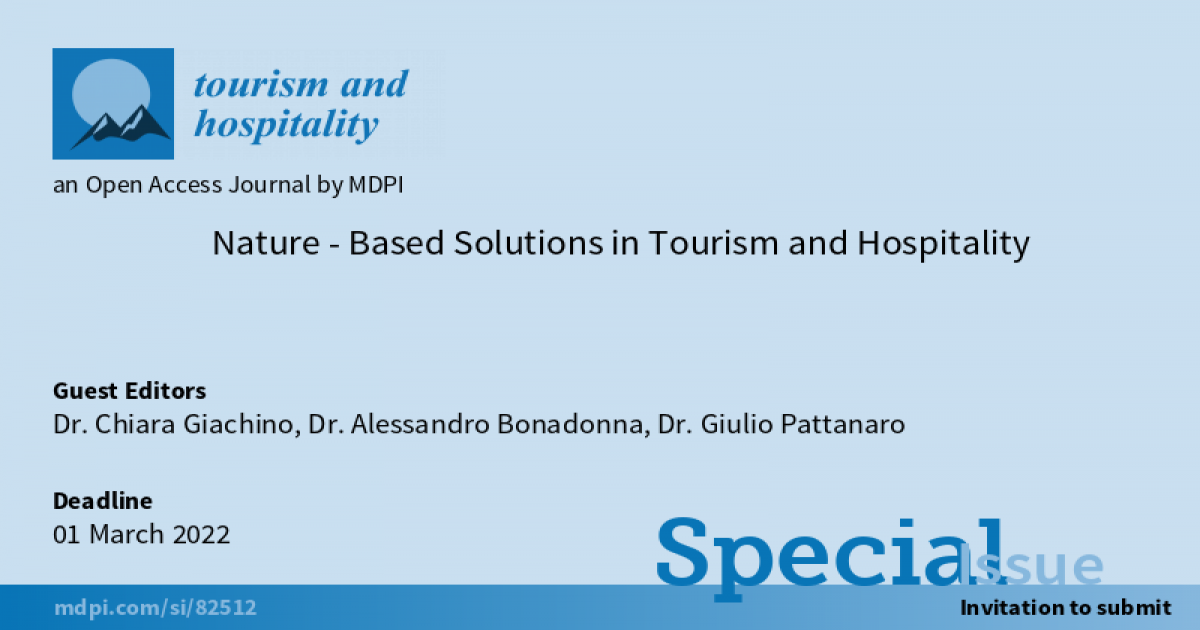- 3.7CiteScore
- 18 daysTime to First Decision
Nature-Based Solutions in Tourism and Hospitality
Special Issue Information
Dear Colleagues,
The search for solutions, which are sustainable from both an environmental and social point of view but also capable of generating economic profit/benefits, has become important for the tourism sector. This is also due to the ever-increasing demand for greener and more environmentally friendly tourism products. In this context, the tourism sector is more and more oriented towards designing and developing innovative products, initiatives and infrastructures that make use of existing natural solutions and combine natural, cultural and manufactured heritage in a coherent manner; the so-called nature-based solutions.
The Tourism and Hospitality journal is planning a Special Issue to explore the potential of nature-based solutions in tourism and in the following context: mountain, urban, rural and disadvantaged areas.
Possible research questions and topics might include (but are not limited to):
- How can nature-based solutions be defined? Has their definition evolved over time?
- Are nature-based solutions an attractive element for tourism development?
- Are nature-based solutions an attractive element for tourists? For which segment of tourists in particular?
- Is there a different perception among generations about nature-based solutions?
- What is the role of social media in raising awareness about nature-based solutions?
- In the pandemic period, can nature-based solutions be seen as an attractive element for tourists?
- What makes nature-based solutions of interest for the development of tourism, and mountain tourism in particular? Are there any best-practice examples?
- How can marketing help the development of nature-based solutions in tourism?
- Which are the most interesting projects/perspectives of nature-based solutions in urban context?
- How can the geography of an area be modified by nature-based solutions?
Studies that use real-time data are particularly welcome. Quantitative studies based on microdata are especially appreciated. Case studies for specific regions, surveys and reviews on topic are also welcome.
Dr. Chiara Giachino
Dr. Alessandro Bonadonna
Dr. Giulio Pattanaro
Guest Editors
Manuscript Submission Information
Manuscripts should be submitted online at www.mdpi.com by registering and logging in to this website. Once you are registered, click here to go to the submission form. Manuscripts can be submitted until the deadline. All submissions that pass pre-check are peer-reviewed. Accepted papers will be published continuously in the journal (as soon as accepted) and will be listed together on the special issue website. Research articles, review articles as well as short communications are invited. For planned papers, a title and short abstract (about 250 words) can be sent to the Editorial Office for assessment.
Submitted manuscripts should not have been published previously, nor be under consideration for publication elsewhere (except conference proceedings papers). All manuscripts are thoroughly refereed through a single-blind peer-review process. A guide for authors and other relevant information for submission of manuscripts is available on the Instructions for Authors page. Tourism and Hospitality is an international peer-reviewed open access monthly journal published by MDPI.
Please visit the Instructions for Authors page before submitting a manuscript. The Article Processing Charge (APC) for publication in this open access journal is 1200 CHF (Swiss Francs). Submitted papers should be well formatted and use good English. Authors may use MDPI's English editing service prior to publication or during author revisions.
Keywords
- nature-based solutions
- mountain tourism
- urban areas
- rural areas
- proximity tourism
- domestic tourism
- sustainable tourism
- eco-tourism
- social media
- sustainable development

Benefits of Publishing in a Special Issue
- Ease of navigation: Grouping papers by topic helps scholars navigate broad scope journals more efficiently.
- Greater discoverability: Special Issues support the reach and impact of scientific research. Articles in Special Issues are more discoverable and cited more frequently.
- Expansion of research network: Special Issues facilitate connections among authors, fostering scientific collaborations.
- External promotion: Articles in Special Issues are often promoted through the journal's social media, increasing their visibility.
- e-Book format: Special Issues with more than 10 articles can be published as dedicated e-books, ensuring wide and rapid dissemination.

